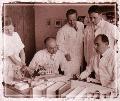
DMT-Nexus member
 
Posts: 12340 Joined: 12-Nov-2008 Last visit: 02-Apr-2023 Location: pacific
|
I am trying to figure out what effects harmalas alone have on either of these receptors..harmine, harmaline and THH all have such a similar structure to tryptamines like DMT, and share the same indole ring structure, and are definatily psychedelic on they're own, and while distinct, also seem to have enough in common with the tryptamines at certain doses that I would call them traditional psychedelics before I called them anything else..they are definatily not just maoi's and the categorization of them as such seems overly generalized. I have seen it mentioned randomly that these harmalas do have some action at the 5ht2a site, but how much? I feel like the effects are more then just upregulation of seratonin and dopamine..they seem to share so much in common with other 5ht2a/2c antagonists like the tryptamines and phenethylamines, that the harmalas seem to be a third class of "classical psychedelics", yet you dont here people like Dave Nichols even mention them. He even goes so far in one talk as to say that oral DMT is just the same as smoked other than route of administration, which I think anyone who takes DMT orally(which almost guarantees harmalas are used) knows that the experience differs to a degree. Any information on the understanding of how they effect these receptor sites would be appreciated. Long live the unwoke.
|
|
|
|
|
DMT-Nexus member

Posts: 4639 Joined: 16-May-2008 Last visit: 24-Dec-2012 Location: A speck of dust in endless space, like everyone else.
|
Each psychedelic has it's own profile of receptors it's active on and the ratio of activity between them. If harmala's are active on 5ht receptors, it could be a simmilar activity as the classic hallucinogens have, but then the difference between those and the harmala's would just be about the other receptors it's not active on.
I wouldn't know these things. I dó know that harmala's have something in common with ibogaine. Ibogaine is also a tryptamine that has some effects that are a bit like the other tryptamines but not quite like them at the same time. In a poll about ibogaine i put up here, there seemed to be a great consensus that ibogaine, of all substances it has simmilarity's with, is most simmilar to harmala's. More simmilar to harmala's even than with NMDA-antagonists like ketamine.
There is also a very strong synergy between harmala's and ibogaine. (very dangerous to combine btw, for those who would read this and feel inspired to try) The synergy is so strong even, that micro doses of ibogaine combined with caapi, can already give some of the effects that normally would only be experienced with flood doses of ibogaine.
My guess would be that harmala's and ibogaine have a strong overlap in the tryptamine-part of their 'receptor-profile'. Ibogaine and harmala's probably have the same activity on the 5-ht receptors.
|
|
|

DMT-Nexus member
Posts: 88 Joined: 18-Jun-2009 Last visit: 28-Oct-2019 Location: Yourope
|
Polytrip, my tests with 1 tbs each of peganum h. seeds followed by iboga r.bark ( both swallowed after 20 mins of "mouth soaking" with Sodium Bicarbonate) resulted in a weak experience.
|
|
|
DMT-Nexus member
Posts: 55 Joined: 10-Nov-2010 Last visit: 08-Nov-2014
|
I was under the impression that at least one of the harmala alkaloids was known to be a NMDA antagonist, which would by itself completely explain the hallucinations anyway, but I also remember reading that dissociatives like ketamine and PCP had direct effects at 5-HT2 receptors related to their NMDA affinity, and also that THH is a SSRI, which along with the MAOI properties of the other harmalas would also stimulate those receptors. DXM gains some of its visuals in high doses from blocking serotonin reuptake so it's not unheard of. In my experience they do seem much more like dissociatives than classical psychedelics and I would doubt that they hit those receptors directly like DMT, psilocin, etc. Unfortunately at the moment I'm stuck using my cellphone for internet and I can't easily get links for the articles where I read that stuff but I know they're out there.
|
|
|

DMT-Nexus member
Posts: 258 Joined: 01-Sep-2010 Last visit: 02-Apr-2015
|
I would be interested to know the data on the B-Carbolines as well. I really liked the little chart that James Kent had in Psycedelic Information Theory with all the different 5HT receptor affinities, but unfortunately no harmine etc to compare. I did check the reference online which has a few more things than listed in Kents book, but still no Harmine. http://www.plosone.org/a...009019#pone-0009019-g001If you wanted to shell out some money I would have to assume that this scientific article would have the information. I found this in a little google search it is called "Serotonin receptor interactions of harmaline and several related β-carbolines " from 1981 apparently. I can't seem to easily find anything referencing it after a brief search. http://www.sciencedirect...f00303d&searchtype=a
|
|
|

DMT-Nexus member
 
Posts: 1139 Joined: 14-Jul-2008 Last visit: 01-Apr-2017 Location: USA
|
Beta-carbolines have very low affinity for 5-HT2 sites (See Glennon et al. 2000). I have some other articles on this somewhere I can try to find it if your interested. In addition to MAOI that act at other receptors which may mediate their effects. Also elevation of monoamines by MAOI's and monoamine re-uptake inhibitors (SSRI's, DRI, etc) lead to hallucinogenic (NOT psychedelic necessarily) effects. The fact that structurally diverse agents all can lead to this effect seems to support a role for monoamine elevation in such effects. Elevated 5-HT levels could stimulate 5-HT and other receptors that psychedelics target and thus explaining some similarities. Most people however do not find betacarboline's psychedelic in any classical sense [Shulgin. TIHKAL].
Also most studies have found that tryptamines and phenethyl(isopropyl)amines psychedelics act as
agonists (or partial agonists) [Acuna-Castillo et al. 2002; Nichols et al. 1994; Parrish et al. 2005] NOT antagonists at 5-HT2 sites. One study I've seen show phenethylamines to act as 5-HT2a antagonsits in african frog Oocytes [See. Villalobos et al. 2004].
In addition to differences in affinity at 5-HT receptors these drugs activate different second messanger pathways with different potency and efficacy (Parrish et al. 2005). Two agonists of the same receptor with similaur affinity may lead to very different effects, this is called ligand or agonist directed trafficking.
The classical hallucinogens bind to an array of CNS receptors (See Ray 2010). Although 5-HT2a receives the most attention, it has NOT been shown to mediate the effects of these compounds in man. And many researchers are beginning to question its significance. While 5-HT2a antagonists ketanserin and risperidone did attenuate much of psilocybin's subjective effects in man [Vollenweider et al.] these agents are in no way selective and bind to numerous other sites targeted by the psychedelics. Haloperidol is also suspected to behave as a 5-HT2a antagonist however it failed to attenuate the major effects of psilocybin. More work is needed on this fascinating topic.
Plus its important to keep in mind when looking at receptor affinity values (Ki or IC50) that many of the binding studies have been done with non-selective agents including DOI. Thus what we call 5-HT2a differs depending on the source of the receptor. Studies in cells with cloned receptors tend to show lower 5-HT2a affinity than those using rat brain for example. In addition studies with agonist directed trafficking studies of selective second messenger activation no specific pathway could be linked with psychedelic effects. Several non-psychedelics also bind to 5-HT2a with very high affinity. So 5-HT2a just's happens to be one of the first sites that these compounds were found to bind to and thus has received the greatest attention. Don't get too caught up with 5-HT2a the truth is we have no idea what receptors mediate the subjective effects of psychedelics. 6 TAARs (DMT and other hallucinogens bind to TAAR1) were just discovered 10 years ago. So many unknown factors exist.
In regards to the comment on James kent's tables I don't know about his book but on his site some of the affinity tables (Taken from Ray. 2010) that I saw were incorrect. Just double check if citing.
|
|
|
DMT-Nexus member

Posts: 119 Joined: 21-Jan-2011 Last visit: 19-Jul-2011
|
Excellent information pulling bufoman. Nothing else to add other then this was essentially what I had believed as well. It's been fun. Thanks for all the wisdom.
|
|
|

DMT-Nexus member
 
Posts: 12340 Joined: 12-Nov-2008 Last visit: 02-Apr-2023 Location: pacific
|
hey thanks bufoman for all that info! here is a link I found to a study where harmalas were used in rats who were trained with ibogaine as a discriminative stimulus.. http://www.ncbi.nlm.nih.gov/pubmed/9600629Long live the unwoke.
|